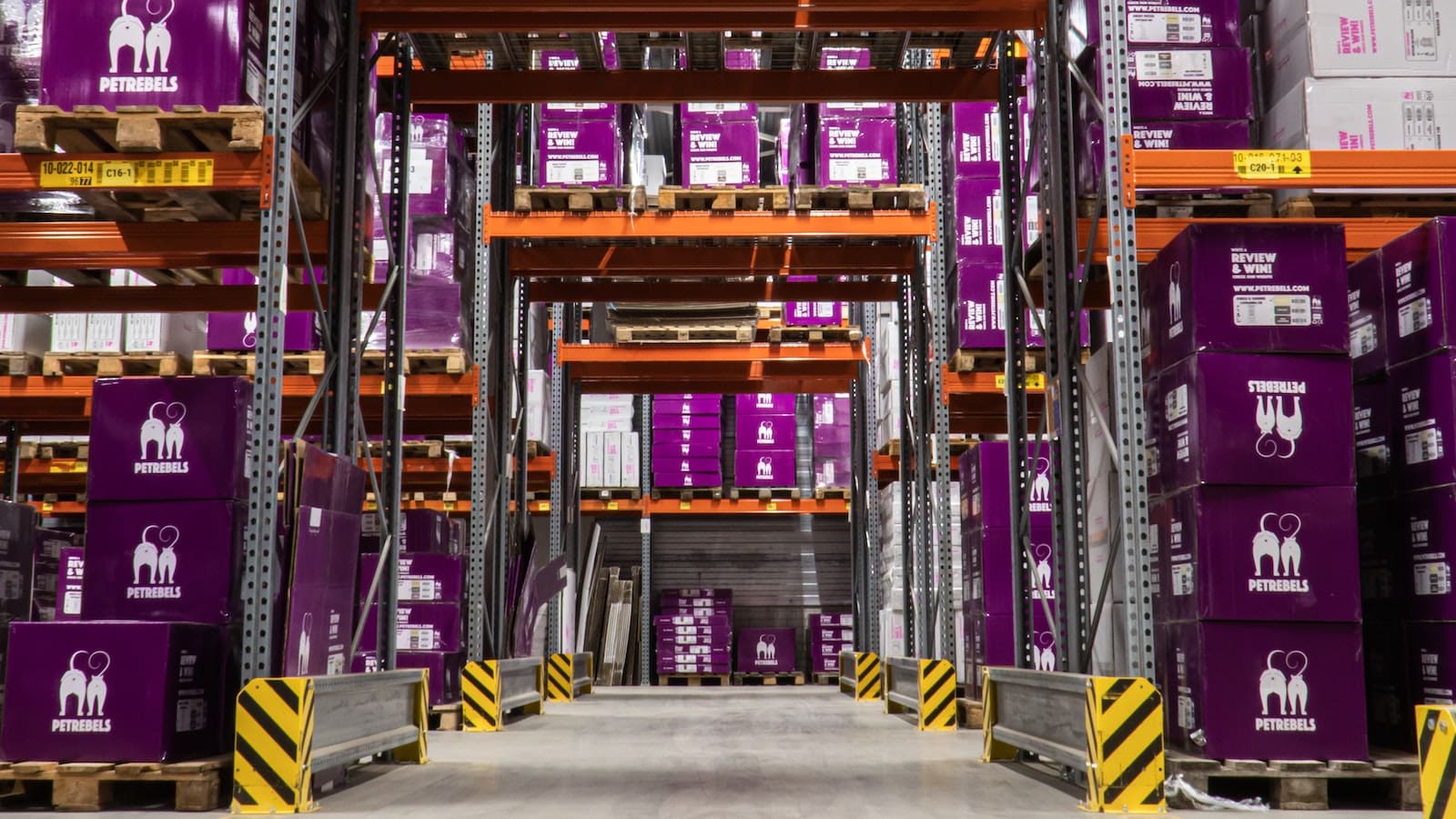Table of Contents
** Minutes
What is vendor-managed inventory?
What makes VMI different from other inventory management methods?
When VMI isn’t the best solution
When to consider 3PLs as a VMI alternative to manage your inventory
How ShipBob solves inventory and fulfilment challenges for growing brands
Thanks to logistics automation and technological advancements, developing a streamlined ecommerce supply chain has become more accessible and cost-efficient than ever before.
While this is good news, it also sets higher expectations among consumers who have learned to expect product availability at all times.
To stay competitive, ecommerce businesses are constantly striving for optimised inventory management processes and experimenting with different inventory models.
To best manage inventory, vendor-managed inventory is one option you might be considering.
This article offers insight into what vendor-managed inventory entails and how it works, so you can decide if this is the right inventory model for you.
What is vendor-managed inventory?
Vendor-managed inventory (VMI) is an inventory model in which the manufacturer or supplier handles decisions around managing and maintaining inventory for a business (or buyer), while the physical inventory is on the buyer’s premises — not the supplier’s.
With a VMI model, the supplier is responsible for inventory replenishment and managing storage costs on the business’s behalf, while the business maintains possession of the inventory.
In other words, VMI is a much closer partnership than a typical supplier and buyer transaction.
For VMI to work, the ecommerce business would have to share the inventory data with the supplier. The supplier would then use this information to make decisions about replenishment in terms of frequency and order size.
What makes VMI different from other inventory management methods?
Typically, inventory management involves the following: once inventory is ordered, delivered, and received, then it’s up to the ecommerce business on how to store, manage, and reorder inventory.
A business could store inventory in an office, storage unit, or even their home. But in most cases, inventory is stored in a leased warehouse where they are responsible for managing the stock.
Another method is to partner with a third-party fulfilment (3PL) provider to store inventory and fulfil orders on the business’s behalf. In this model:
- Inventory is stored in the 3PL’s fulfilment centre(s) and the business has access to inventory management data as the 3PL receives, stores, and ships our their inventory to consumers and/or other businesses.
- The 3PL should also provide real-time data on inventory levels and reorder point notification capabilities, so the business has access to insights to make timely replenishment decisions.
With vendor-managed inventory, the business still stores the inventory in their warehouses while the supplier manages it for them. The biggest differences between the 3PL and VMI inventory models are:
| Inventory model | Who reorders inventory | Who stores inventory |
| 3PL | The business themselves | The 3PL |
| VMI | The supplier | The business themselves |
Who uses VMI?
Vendor-managed inventory is a good option for different types of businesses and is even considered a standard in certain parts of the retail sector.
It’s a common practice in both the consumer packaged goods and electrical industries.
However, it’s most ideal for ecommerce retailers with lots of physical space to store inventory and who want to bypass the hassle of managing a great number of SKUs.
In fact, big-box retailers like Amazon, Walmart, and Home Depot rely on VMI so they don’t have to manually place purchase orders.
This is a good option for them, as they deal with millions of SKUs and work with many third-party sellers.
But even if you have to deal with an expansive collection of SKUs like Amazon, you don’t necessarily have to rely on VMI to manage your inventory.
With a robust inventory management system, you can automate most of your inventory management processes and even get notified when it’s time to replenish your stock.
This ultimately gives you more visibility and control over your inventory.
Downsides to VMI
Although VMI relieves ecommerce businesses of time-consuming inventory management tasks, there are some limitations to be aware of when dealing with a VMI model.
Here are some of the biggest downsides to VMI.
Lose control of your inventory
A necessary part of VMI is handing over inventory management to a supplier or manufacturer, while you only keep track of the movement, physically store it, and then share the data with the vendor.
In other words, outside of the inputs and physical possession, you have minimal control over your inventory as decision-making is up to the supplier.
With VMI, you have little to no say in the frequency of inventory replenishment or the order size as the vendor handles all of those details on your behalf.
Not having proper inventory control is risky; it can cause several problems further down the line, from inventory discrepancies to an increase in costs, as well as a higher risk of deadstock and stockouts.
Loss of options
In vendor inventory management, it’s easy for ecommerce businesses to become too reliant on their supplier.
When this happens, it’s difficult to dissolve the relationship and switch to other suppliers, even for cost or convenience because it could result in a disruption to your supply chain.
It’s common for ecommerce businesses to partner with multiple suppliers to establish a more agile supply chain and reduce risk, but VMI limits the ability to do so.
Meanwhile, the existing supplier may take advantage of the opportunity to raise prices, reduce quality, or offer poorer service.
Less control of data
An essential aspect of VMI is sharing your inventory data with a third party.
Since you don’t have control over who gets to see your data once you share it with the vendor, there’s a lack of assurance about data security.
This could leave you vulnerable to malicious attacks or data leaks that can cause significant harm to your business.
When VMI isn’t the best solution
While VMI is an accessible inventory management option for many businesses, it’s not necessarily the best solution in the following scenarios.
When selling high-value commodity items
VMI is ideal for lower-value items that are high in demand and have predictable consumption.
High-value commodities like jewelry, expensive manufacturing parts, and luxury items need higher levels of security and are therefore not suitable for vendor-managed inventory.
Moreover, higher value items may not always see consistent demand, which means that you may end up with excess inventory when sales are slow.
Ecommerce businesses need more insights into demand forecasting, customer behaviour, and future trends. When selling a high-value item, it’s best to have more control over your inventory, so you can make the best decisions yourself.
When you can’t afford sufficient warehouse space
In a vendor-managed inventory system, the supplier may be responsible for managing the inventory, but you’re still responsible for storing the inventory. And warehouse space can get costly.
This makes the VMI inventory method a challenge for some businesses if they can’t afford to physically store large amounts of goods that are often needed to offset the costs associated with VMI to make it worth the investment.
In this case, it might be a better option to use a third-party logistics company like ShipBob. ShipBob’s network of fulfilment centres across the globe is an affordable option and allows you store your inventory in multiple locations.
ShipBob offers multichannel retailing and B2B fulfilment solutions, so you can expand your business, optimise costs, and still maintain control.
“We love that ShipBob allows us to keep low overhead by not having to do shipping ourselves.
Having the ability to outsource that to a third party logistics company that could provide us affordable pricing, customer service, and a software platform that was really intuitive that was linked to our website and all the rest of our platforms, giving us all those real time insights — it was a game changer.”
Nathan Garrison, Co-Founder and CEO of Sharkbanz
When your market changes rapidly
For fast-changing markets, such as electronics, apparel, and beauty and wellness, being able to anticipate a possible change in demand at any time is essential. And the party with the greatest vested interest should be the ultimate decision-maker.
Having complete control over your inventory is crucial in most direct-to-consumer markets, so you have accurate insights on sales forecasts and market shifts to help you maintain a healthy supply chain and make agile changes yourself.
As a result, a vendor-managed inventory method isn’t an ideal option for most direct-to-consumer brands. You’ll often have to deal with obsolete inventory as the demand shifts to newer and better products.
Alternatively, you may regularly experience stockouts because you couldn’t foresee an increase in demand or your vendor couldn’t replenish your inventory on time.
In fact, one case study revealed that a large electronics manufacturer experienced increased material shortages after moving to VMI.
There was reduced demand visibility and increased forecasting inaccuracies that hindered the supply chain’s effectiveness.
Centralising inventory-related decisions from the company selling it to the end consumer (and not manufacturing the product) was necessary for business viability.
Increased vulnerability from data exposure to a third party
In a VMI inventory method, you’re handing over important inventory data to a third party. This comes with increased vulnerability even if you’re working with a reliable vendor.
For example, a security breach in the vendor’s system could expose your data to malicious hackers. Or an unscrupulous vendor may try to use your sensitive information to their advantage in case your relationship with them fails.
When you need a high level of control over your business
No one knows your business better than you, so having a high level of control over your inventory is essential if you want to maintain an efficient supply chain.
In vendor-managed inventory, you’re handing over the control of your inventory to a third-party vendor. As a result, it could cause serious problems for your business further down the line. For example, an untrustworthy vendor may decide to send excessive inventory your way (without your signoff), so they can make more profit.
This isn’t financially sound for your business, as you’ll have to pay more in holding costs and you might even end up with unsold inventory, which negatively impacts your profits margins.
When to consider 3PLs as a VMI alternative to manage your inventory
If you want to leave inventory management to the experts but want to avoid all the risks associated with vendor inventory management, working with a third-party logistics company may be an ideal alternative.
Instead of having to store inventory yourself, you can leverage a 3PL’s network of fulfilment centres and only pay for the space you need.
With a 3PL, inventory is sent to one or more fulfilment centres, and stored properly and safely.
Once an order is placed across any sales channel, it is automatically sent to the nearest fulfilment centre to be picked, packed, and shipped.
Many 3PLs, like ShipBob, provide a cloud-based web platform with built-in inventory management software, so you monitor and manage inventory in real time.
How ShipBob solves inventory and fulfilment challenges for growing brands
ShipBob stores inventory and fulfils orders for you, while also providing the tools and resources to optimise the fulfilment and inventory restocking process.
Here’s an overview of how ShipBob solves common inventory and fulfilment challenges.
Increased inventory turnover ratio
ShipBob’s web-based platform gives you real-time inventory visibility into stock movement, providing you with the insights you need to manage inventory turnover for both slow-moving and hot-selling items.
With ShipBob, you can access real-time inventory data, track stock levels from any location, and receive notifications when you need to reorder inventory before you run out.
You also get accurate forecasting insight based on historical sales performance and understand where you might be able to improve inventory turnover.


“We roll out new products and designs on our website 1-3 times a month and send new inventory to ShipBob each week.
It’s really easy to create new SKUs and restock existing ones using ShipBob’s technology, which is especially important with high inventory turnover.”
Carl Protsch, Co-Founder of FLEO
Cut costs
Outsourcing inventory management and fulfilment to ShipBob allows you to reduce business costs in a number of ways.
By storing your inventory across our network of fulfilment centres, you’ll be saving money on distributed warehousing costs by reducing the average transit distance.
Plus, you can also save on administrative costs and labour costs since you won’t have to hire warehouse and fulfilment staff or spend money on managing them.
ShipBob offers a transparent pricing model and you also have the ability to track storage and fulfilment costs from the ShipBob dashboard.
“If I’m completely honest, the deciding factor that sold us on ShipBob was price. International fulfilment can be incredibly expensive, but ShipBob was cheaper than our old provider.
Their New Jersey-based facility in the Eastern region of the US is also more strategically located than our old provider’s warehouse, so it was cheaper to ship inventory to.”
John Greenhalgh, Co-Founder of A Year of Dates
Optimised supply chain and fulfilment
With ShipBob, you can take advantage of logistics automation to optimise different aspects of your supply chain execution without making big investments for in-house technology solutions.
ShipBob’s integrated software automatically connects with your online store(s) and other existing systems, from returns platforms to inventory PO tools.
This allows better visibility across your supply chain and provides crucial information to all parties involved, allowing for better coordination and efficiency.
For example, if you want to sell across multiple channels, you can connect ShipBob’s technology to social media platforms like Facebook and Instagram, as well as major marketplaces like Amazon and Walmart Marketplace to streamline fulfilment all through ShipBob.
In the end, this level of supply chain automation enables orders to go out the door and reach your customers faster.
Ready to take your fulfilment strategy to the next level and save on costs? ShipBob can get you onboarded fast. Learn more by requesting a fulfilment quote.
“Learning to tailor our sales strategy, marketing, and packaging to each retailer’s requirements has been a challenge, but that’s where ShipBob really comes in handy.
ShipBob is EDI-compliant with dozens of popular retailers, and their API integrations make it possible for them to fulfil orders according to each retailer’s compliance guidelines.”
Aaron Patterson, COO of The Adventure Challenge
FAQs
Vendor-managed inventory FAQs
Here are the top questions about vendor-managed inventory.
Who uses vendor-managed inventory?
Vendor-managed inventory is a common practice in the consumer-packaged goods industry and the electrical industry. However, it’s most ideal for ecommerce businesses or retailers with lots of physical space to store inventory and want to bypass the hassle of managing large amounts of SKUs. Big-box retailers like Amazon, Wal-Mart, and Home Depot use this inventory method.
Does ShipBob use VMI as an inventory management practice?
No, ShipBob stores inventory in their fulfilment centres and provides you real-time inventory data and tools to monitor and manage your inventory. You can leverage our network of fulfilment centres to store your inventory and still maintain control rather than leaving it all up to a supplier.
What are the limits of vendor-managed inventory?
The need for large warehouse spaces, lack of inventory control, and security risks are the main limits of vendor-managed inventory.



